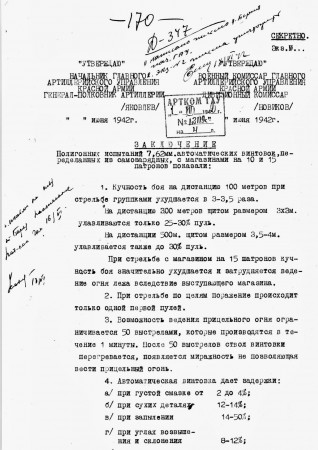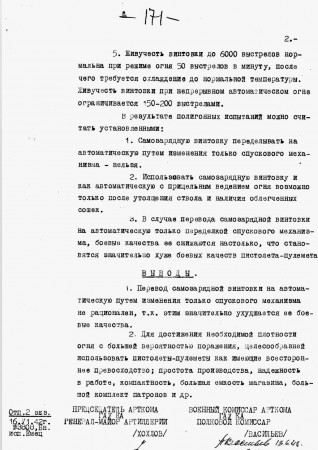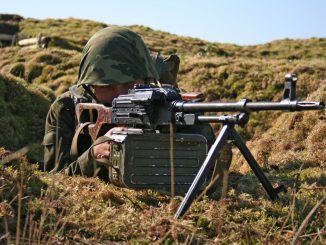While poking around at Soviet Gun Archives (a very cool site which I wish was updated more often), I noticed this two-page memo reporting the results of an experiment modifying SVT-40 rifles to full-auto capability.


To put this into context, the original SVT-38 was updated based on combat experience in Finland, and the SVT-40 formally adopted on April 13, 1940. Although the rifles had some problems (field reports described them as unreliable and inaccurate in combat conditions), they were successful enough that Tokarev went on to design a select-fire variation. The changes were mostly in the trigger group, with the safety lever turned into a selector switch allowing either semi or full-auto fire. The intention was that the rifles could be used in full-auto in limited circumstances to supplement the Soviet shortage of light machine guns and submachine guns. Designated the AVT-40, these rifles went into production in May 1942 – and were taken right back out of production in the summer of 1943.
Mechanically, the SVT-40 was simply not equipped to withstand the rigors of full-auto fire. It suffered from parts breakages, as well as failures to eject, premature unlocking of the bolt, and ruptured case heads. In addition, it was found to be less accurate that the Mosin-Nagant in semiauto and less accurate than the PPSH-4 and PPS-43 in full auto. These problems are detailed in the 2-page report above. Here is a translation, again from Soviet Gun Archives (I have emphasized a couple points that jumped out at me in particular):
Conclusions on the proving ground trials of 7.62 mm automatic rifles, converted from semi-automatic rifles, with 10-15 round magazines showed that:
- Groups at 100 meters when firing in bursts increase by 3-3.5 times.
At 300 meters, only 25-30% of the bullets strike a 3×3 meter target.
At 500 meters, up to 30% of the bullets strike a 3.5-4 meter target.
While shooting with a 15 round magazine, grouping gets worse, and it is difficult to fire while prone due to the protruding magazine.- When shooting at targets, only the first bullet hits.
- The ability to aim is limited to 50 shots over the span of one minute. After that, the barrel overheats, and a mirage effect is achieved, which impedes aiming.
- The automatic rifle jams:
- With thick grease: 2-4% of the time
- With dry parts: 12-14%
- In dusty conditions: 14-50%
- While aiming up or down: 8-12%
- The barrel life is 6000 rounds when firing 50 rounds per minute, after which the rifle was allowed to cool. Continuous fire brings the life down to 150-200 rounds.
As a result of trials, it was concluded that:
- Is is not viable to create an automatic rifle from a semi-automatic one by modifying the trigger group.
- It is only possible to aim with such an automatic rifle when using a thickened barrel and lightened bipod.
- When converting a semi-automatic rifle to fully automatic by only modifying the trigger group, its combat usefulness decreases to less than that of a submachine gun.
Conclusions
- Due to the decreased combat usefulness, conversion of a semi-automatic rifle to a fully automatic one is not rational.
- In order to reach required density of fire with a high probability of hitting the target, it is better to use submachineguns, which have the advantages of simpler production, higher reliability, compactness, high magazine capacity, larger stocks of ammunition, etc.
The US military would discover this ineffectiveness of full-auto shoulder rifles about 15 years later, with the M14 debacle…



Also earlier Russian experiences on shoulder fired full-auto rifle with full-power were negative.
First – Fyodorov Avtomat initially designed for 6.5×57 Fyodorov round (see below for more info) and semi-auto only, however after the outbreak of WW1 rearming of Russian Army in new cartridge was not possible, so the Japanese 6.5mm was adopted. With the weaker cartridge the auto fire was more viable, but nonetheless the single-shots were considered as a default, with full-auto only on very short distance.
Second – AVS-36 – uncontrollable in full-auto fire despite muzzle brake, additionally hard to manufacture
6.5×57 Fyodorov – source: http://ammo-collection.com/index.php?title=6,5%D1%8557_%D0%A4%D1%91%D0%B4%D0%BE%D1%80%D0%BE%D0%B2%D0%B0
bullet: 6,73mm (.264″), mass 9,5g (~147grains), muzzle velocity: 900m/s (~2953fps).
In modern times it would be probably named Magnum, note that these parameters are similar to modern .264 Winchester round! (however prior to WW1 also other armies have their Magnum-mania and created cartridges like 7×57 Meunier or .276 Enfield)
Thanks for the info on the Fyoderov 6.5 round. even with post wwii powders, 6.5 rounds loaded to achieve those figures had a reputation for eating barrels, even on bolt action hunting rifles. On a semi auto or even worse selective fire rifle, Fyoderov’s round would likely have been a disaster.
Unfortunately we still see magnum mania form the military-bureaucratic complex.
.222 Rem and .222 rem mag both had reputations as pleasant and extremely accurate little rounds – both are loaded to approx 40K psi.
5.56x45mm is loaded to over 60K psi; magnum pressures, in an attempt to make it do what it can’t at reasonable pressure levels.
You get the most out of it with longer barrels, and longer barrels can be made more useable when used in bullpup configurations.
But not in the length of a Sa80 but that of the Lsw, however you make this the length of the Sa80 i.e. as a rifle, the Em2 rifle was this length and this length isn’t to long it’s 6″ shorter than an SLR which was to long.
I find pressure for the cartridge in Fyodorov’s Эволюция стрелкового оружия volume 2 page 130 and it is stated as 3500 atmospheres (average) i.e. ~51436 PSI (for comparison Fyodorov states 2750 atmospheres for then-current Russian 7.62×54 Mosin round), also on page 131 Fyodorov states that his rifle with tested cartridge with heavier charge making 4200 atmospheres without malfunctions, excluding break of firing pin.
However Fyodorov also stated other ballistic data: 8,5g (~132grains) at 860m/s (~2822fps). So if this data are true the pressure wasn’t specially big (.30-06 has 60200psi of maximum pressure) and this cartridge was “good performance from big case” rather than “good performance from pressure”.
I liked the Soviet cavalryman pictures, and funny backwards writing. Something to be said for that these days, I.E.D’s on “routine” patrols, I like horses… But, they’d keep your legs away.
The comparison to SMGs is noteworthy. The Soviets used SMGs differently from most armies. They armed entire units with them rather than just handing them out to one or two men in a section. Those SMG units would be used in final assaults where the high rate of fire would suppress enemy defences at close range.
Weapons have to be evaluated in terms of how they fit into an army’s doctrine. It would be interesting to see how the Soviets’ view of the role of different weapons actually evolved with experience rather than to project our own views on what we think they did.
The above post mentions that the AVT-40 was taken out of production in the summer of 1943. The M-43 7.62x39mm cartridge was developed in 1943. It would be fascinating to know if their experience with the AVT-40 influenced their view of whether to proceed with the M-43 cartridge, the SKS rifle, and the other associated family of weapons (RP-46, AK-47, etc.).
Actually SVT-40 production ended in fall 1942 and all rifles produced until January 1945 were AVT-40s.
During World War One, Mauser in Germany did some experimentation with selective-fire versions of their own self-loading rifle prototypes, as well as the Swiss-made Mexican Mondragon gas-operated rifle. They weren’t thinking of infantry use, but rather as armament for scouting aircraft in early to mid-1915.
They found the same thing that the Russians learned with the AVT-40. The self-loading rifles were basically uncontrollable in full-auto fire, and barrel and action heating was a major “issue”. Although in aircraft use, the slipstream cooling effect may have helped that a bit.
They came to the conclusion that lightening the standard water-cooled heavy/medium machine gun and converting it to air-cooling was a more workable solution. Plus, it was belt-fed, rather than having the gunner constantly changing box magazines.
The moral being “never try to use a self-loading rifle to do a machine gun’s job”.
I don’t think that it’s a coincidence that German experimentation with “intermediate” cartridges and machine carbines to fire them was well underway before the invasion of Poland. They realized that such a combination could do most of the jobs they used SMGs and rifles for, while simplifying supply and etc.
Besides, they saw the “full-bore rifle caliber” GPMG as the primary killer in the infantry section anyway, which still seems to be the most efficient arrangement.
cheers
eon
The assault rifle concept came from WW1 I think i.e. storming static positions, trenches etc. In regards it’s development from the sub machine gun, for the same purpose. Because it was impractical to hold a maxim at the hip and let rip while moving quickly, unless you happened to be Arnold Schwarzenegger. If you move forward to WW2 and the German assault rifle, it was really they simply managed to finally do it for WW1. They wanted a semi auto, like the Garand etc because others had them. They managed to do it, by creating a intermediate cartridge i.e. between a smg and rifle. So by the time of the M14 why did they bother trying to have a rifle round act as a smg, when it didn’t work because of recoil etc. Well you know, lets think when do you use full auto now in say an Sa80 in 5.56mm? You don’t, unless you’ve posted a grenade into a bunker or a room and you want to attempt to add some more “shrapnel” as the more there is, the better chance of some hitting someone. In other words, you don’t aim anyway in full auto so control is neither here no there within 10 feet.
I think the assault rifle is defunct, just use two grenades. The intermediate round also, because the concept of “contacts” happening within 300 metres is before telescopic sights or battlefield electronics detecting movement etc. I look at it like this, if we used Em2’s now with fancy modern sights mounted like those on AR’s and we met some Russians with iron sighted Ak74’s we could out range them. And them spraying us at ten feet, wouldn’t be an issue because they would already be dead by accurate fire.
http://world.guns.ru/assault/rus/ak-10710-e.html
That Ak 107 system or similar would help the notion of an M14, conversely in Afghanistan there was a problem with being out ranged apparently which wouldn’t have happened with M14’s.
The Germans at the time were obsessed with WW1, hence why WW2 happened. They didn’t accept they lost, you see. So the assault rifle was like “Hah, hah! Now you vill see, we vill vin ze war now!” decades to late.
The AK-107 only needs one thing to make it practical; a 7mm-class round to give it about 450 meters effective range.
Beyond that, use a GPMG in 7.62 x 51R or the equivalent.
Better yet, use a mortar. Or an airstrike.
cheers
eon
You Yankee folk keep saying airstrikes, you must have a different phone number to us, our lot would laugh and put the phone down, give us the one you have and i’ll email it the MOD he he 🙂
Air plane “petrol” costs money, can’t you throw more stones, beeeeeeep…
Probably because we have no planes, and they are embarrassed to ask you.
Which backfires accordingly, because there’s not enough loose stones.
Ah, how prescient the Soviet firearms testers were — history simply repeated itself in the case of the M-14. To be fair, I am reasonably sure that we could all unearth numerous cases of similar, repeated lessons learned that never got beyond national borders or, for that matter, nationalistic mindsets. An extremely compelling case in favor of the need to constantly and consistently keep an open mind, stay in touch with developments and to be in a position to take advantage of them, regardless of origin or political or cultural affiliation — and certainly a sensible and complete refutation of the “Not Made Here” syndrome, along with it’s equally ridiculous concomitant “If it ain’t American ( or substitute whatever is suitable for the situation at hand ), it ain’t s**t”. Half-baked parochialism, along with a corresponding cultural or ethnic bias, will get you exactly what is to be expected ( or worse ) — half-baked proofing trials, along with misleading conclusions and follow-up actions that miss the mark, sometimes with embarrassing results at best, and disastrous aftermaths at worst.